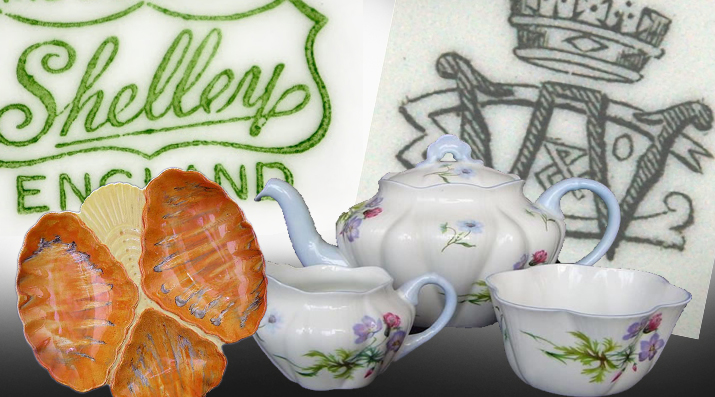
SHELLEY POTTERY
Shelley Potteries, situated in Staffordshire, was earlier known as Wileman & Co. which had also traded as The Foley Potteries. The first Shelley to join the company was Joseph Ball Shelley in 1862 and remained a Shelley family business until 1966 when it was taken over by Allied English Potteries.
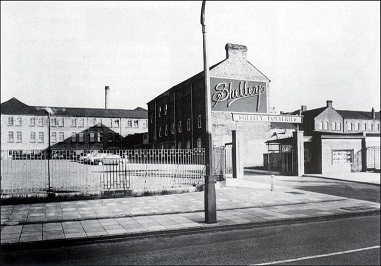
In 1881 Joseph Shelley’s son, Percy, joined the company. Joseph Shelley died in June 1896, leaving Percy in complete control of the company. Percy wanted to improve the company and in 1896 he employed Rowland Morris. Morris was a ceramic designer and went on to design the ‘Dainty Cup’ shape. This shape became very popular, especially in the USA after World War II and continued in production until the takeover in 1966.
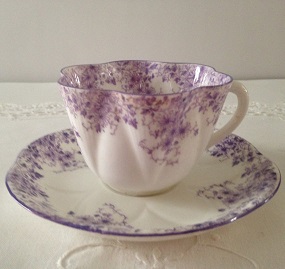
Shelley is probably best known for its fine bone china ‘Art Deco’ fashionable tea ware.
The well-known Frederick Alfred Rhead was employed in 1896, as the Arts Director. Rhead brought his own kind of skills to the company and introduced several ranges of china and earthenware, this enhanced the company’s reputation further.
A decorative range of earthenware called “Intarsio” was one of Frederick Rhead’s major contributions to the pottery. He left the company in 1905.
Walter Slater then took over as Arts Director. The Slater name was another well-known family name in the pottery industry. Walter was an apprentice at Mintons in the late 1870s before moving to Doulton, at Nile Street, Burslem, under the direction of his uncle John Slater.
In 1910 Percy Shelley decided to try to register the “Foley” name as its trade name as the china was still marked Foley China. Another company that also used the “Foley” name on its backstamp objected and this resulted in a court case where it was judged that Wileman’s could not have the exclusive claim to use the name. Percy Shelley changed the name to “Shelley”, which was placed within a shield. From 1910 to 1916 the words “Late Foley” were put over the top of the shield. Shelley’s placed advertisements advising the public of the changeover – one statement read:
‘The world-wide reputation of “Foley” China has caused many cheap imitations and in future, to protect the public, the real and genuine “Foley” China will always be indelibly marked “Shelley” China, a trademark which is a guarantee of the highest excellence.’
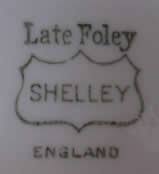
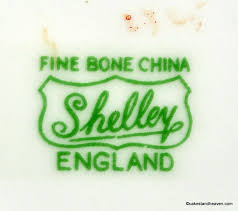
In 1911 the economic situation had started to improve and Walter Slater was given more artistic freedom. He started to develop ornamental pottery and earthenware, as well as supervising the development of fine bone china. By 1914, Shelley had started to make a name for itself by producing dinnerware in china as opposed to high quality earthenware. Within a few years it proved to be a great success.
The company was still called Wileman & Co, even though it had been controlled by the Shelley family for over fifty years and on 1st January 1925 the Shelley name and trademark were registered.
The period of the mid-twenties until the start of World War II was Shelley’s most productive years. It was during this time that the Art Deco period was proving to be very successful with the various Deco shapes that were designed.
In the mid-twenties Shelley broke with tradition and employed a well-known illustrator of the time, Hilda Cowham, to produce a range of nursery ware. Cowham designed a series called Playtime; the design was a simple representation of children’s activities. A second series of designs were produced in 1927 and in 1928 a tea set with a seaside theme was produced. The teapot was a bathing tent, the sugar bowl was a sea side bucket and the milk jug was in the shape of a shell with a seaweed handle.
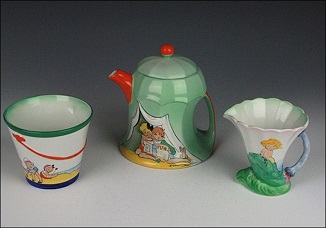
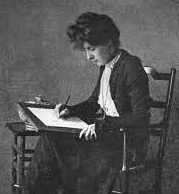
In 1926 a second well known illustrator, Mabel Lucie Attwell, was introduced. Her first six designs portrayed scenes involving children, animals and small green elves in green suits – these were called ‘Boo Boos’. Mabel Lucie also produced a tea set, the teapot was in the shape of a mushroom house, the sugar bowl was a mushroom with the top cut off and the milk jug was a green ‘Boo Boo’ in a coy saluting pose.
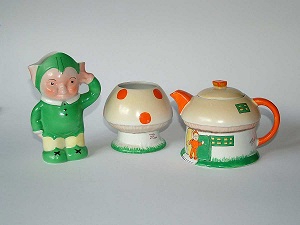
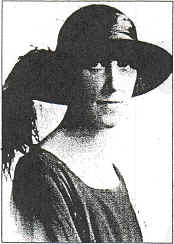
These designs were well liked and they sold very well.
Whilst Shelley was now renowned for its Fine China, the factory also produced normal run-of-the-mill table ware, although items such as jelly moulds broke with tradition as the shape was seen on the outside of the mould and not just on the inside.
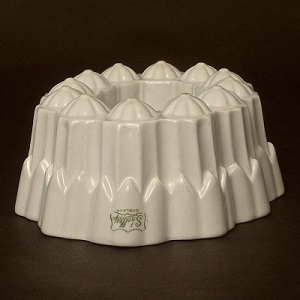
The success of the company continued into the late thirties until war was declared in September 1939. In June 1942 a complete ban on decorated ware was imposed on the UK market. Decorated ware was still being produced for export, as exports were a vital source of income for the UK.
The war ended in 1945, but it was several years before the restrictions were fully lifted.
Shelley continued to hold its own on the pottery manufacturing side of the business even though new technology was starting to change the face of the pottery industry and the old bottle kilns were becoming redundant. In May 1965 Shelley Potteries Ltd changed their name to Shelley China Ltd.
In June 1966 Shelley China Ltd became part of Allied English Potteries (A.E.P.). After fulfilling all outstanding orders, the production of Shelley ware ceased. The factory was named “Montrose Works” and Royal Albert ware was produced at the works until the early eighties. Royal Doulton was also part of A.E.P., and as Royal Doulton was better known, the Royal Doulton name came to the fore. When the factory closed most of the old buildings were demolished. All of the Shelley facilities are now gone. Only its history and its unmatched products carry on to this day.
Shelley China is still very popular and sought after by many collectors. Potteries Auctions sell a large quantity of Shelley tea ware in their sales. Some of the items below are from recent Antiques, Rare Pottery & Fine Art Auctions.

Lot 13 – A good Shelley part tea set in pattern F2160 to include cups, saucers, side plates, six fruit dishes and a large bowl etc. Sale Price £55.00.

Lot 18 – Shelley Wild Anemone 21 piece porcelain tea set pattern no 13977. Sale Price £90.00.

Lot 385 – A collection of Shelley floral decorated tea ware in wild roses pattern to include dinner plates, side plates, cups, saucers, etc. Sale Price: £65.00.
If you have any Shelley Pottery that you would like to sell, please contact us on telephone 01782 638100.
Selling Shelley at Auction
If you have Shelley pieces you’re looking to sell, their pieces
consistently perform well at auction and our staff is well-placed to provide
valuations and advice on selling your items. Call 01782 638100 or
emailenquiries@potteriesauctions.com to book a valuation appointment to attend
one of our Tuesday valuation days. We also provide valuations via WhatsApp,
simply send some clear photographs of your items via the app to 07864 667940.
Additionally, we can send you links to our catalogues via WhatsApp–message the
above number via the app and ask to receive our catalogues. Make sure you are
subscribed to our email newsletters, too!
